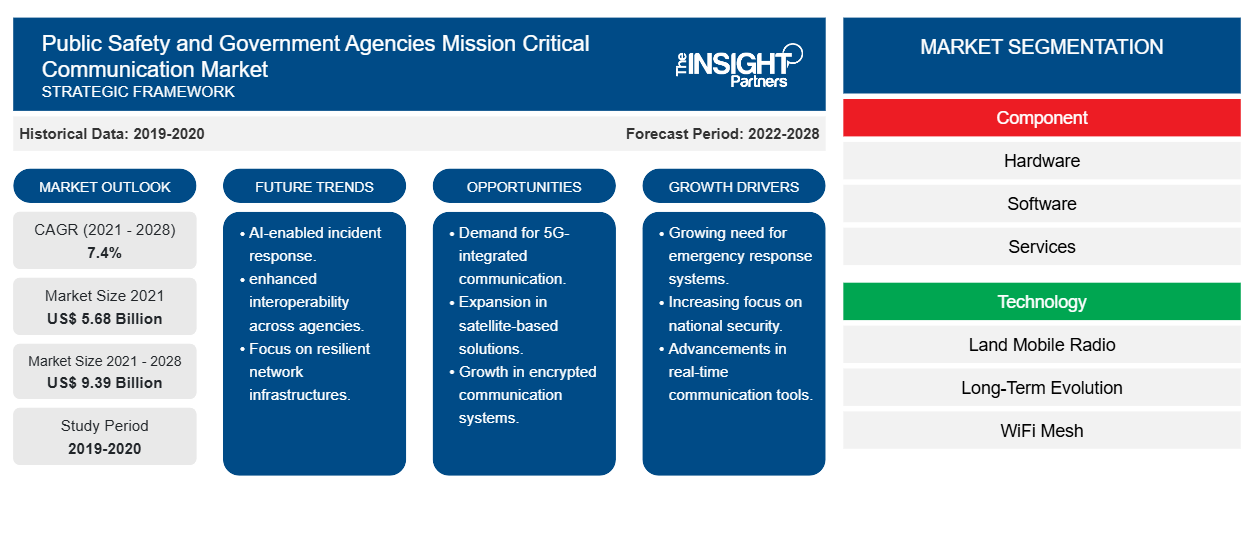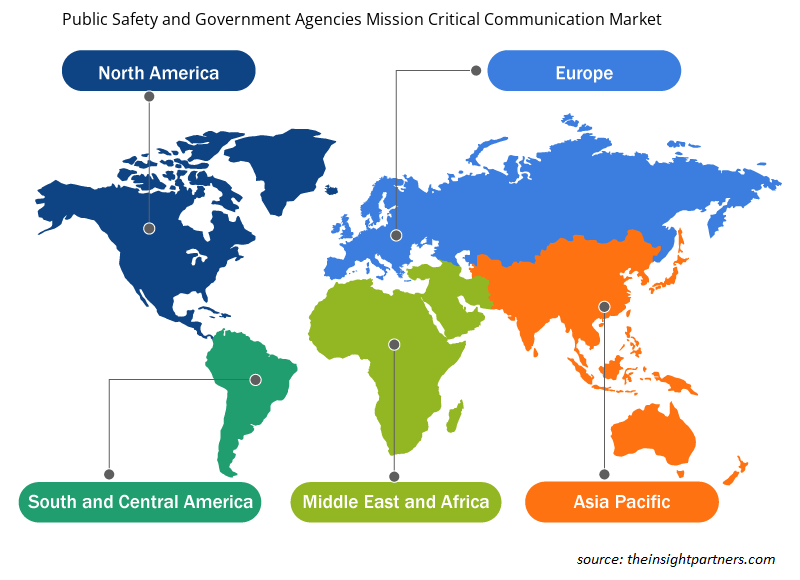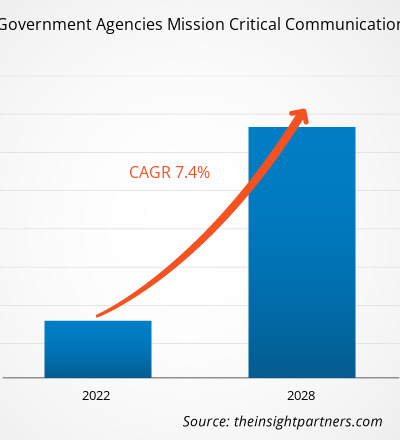Le marché des communications critiques pour la sécurité publique et les agences gouvernementales a été évalué à 5 684,3 millions USD en 2021 et devrait atteindre 9 390,0 millions USD d'ici 2028 ; il devrait croître à un TCAC de 7,4 % de 2021 à 2028.
Une communication critique implique des solutions qui facilitent les méthodes de communication avec les utilisateurs finaux dans des situations où les systèmes traditionnels ne parviennent pas à répondre à leurs demandes. En outre, le marché des communications critiques pour la sécurité publique et les agences gouvernementales facilite la communication et prend en charge les opérations qui présentent des dangers pour les personnes et les biens. Des appareils de communication cruciaux sont utilisés pour informer les gens sur les situations critiques. Sur le marché des communications critiques pour la sécurité publique et les agences gouvernementales , les opérateurs de réseau se concentrent sur de nouvelles stratégies de conception et de gestion des infrastructures de communication pour répondre à l'évolution rapide du réseau et des services afin de garantir un fonctionnement fiable du réseau.
Impact de la pandémie de COVID-19 sur le marché des communications critiques pour la sécurité publique et les agences gouvernementales
L'épidémie de COVID-19 a considérablement affecté le marché des communications critiques pour la sécurité publique et les agences gouvernementales en Amérique du Nord, entraînant des pertes financières substantielles pour les industries utilisatrices finales, les poussant à reporter encore davantage leurs plans de mise en œuvre du MCX. L'épidémie a également eu un impact sur les opérations des sites de fabrication de matériel de communication critique pour la sécurité publique et les agences gouvernementales, nécessitant un bref arrêt. En conséquence, plusieurs fournisseurs importants de composants et de technologies ont réduit leurs coûts et leur production. La demande d'électronique étant restée constante, cela a aidé le marché à reprendre sa croissance.
Personnalisez ce rapport en fonction de vos besoins
Vous bénéficierez d'une personnalisation gratuite de n'importe quel rapport, y compris de certaines parties de ce rapport, d'une analyse au niveau des pays, d'un pack de données Excel, ainsi que de superbes offres et réductions pour les start-ups et les universités.
Marché des communications critiques pour la sécurité publique et les agences gouvernementales : informations stratégiques

-
Obtenez les principales tendances clés du marché de ce rapport.Cet échantillon GRATUIT comprendra une analyse de données, allant des tendances du marché aux estimations et prévisions.
Aperçu du marché
Demande croissante de diverses agences gouvernementales Propulsant la croissance du marché des communications critiques pour la sécurité publique et les agences gouvernementales
Les citoyens attendent des agences gouvernementales un service et une communication 24 heures sur 24. Ils souhaitent un accès facile à des informations correctes et actualisées et une connexion fluide avec les responsables gouvernementaux appropriés. Ils veulent également que les services soient fournis rapidement, efficacement et de manière transparente et que les problèmes soient résolus rapidement, efficacement et ouvertement. De nombreuses agences gouvernementales s'appuient encore sur des infrastructures de communication obsolètes, telles que des systèmes PBX loués ou des systèmes de type Centrex. En outre, sur le marché des communications essentielles à la sécurité publique et aux agences gouvernementales, les gouvernements développent et maintiennent d'excellents systèmes de communication pour être des acteurs respectables dans les sphères publiques. Les facteurs ci-dessus leur permettent d'évaluer les besoins et les préférences des résidents et de promouvoir une arène publique délibérative pour la participation de plusieurs parties prenantes, un débat politique éclairé et l'efficacité du développement d'urgence. Toutes ces questions stimulent la demande pour le marché des communications essentielles à la sécurité publique et aux agences gouvernementales.
Informations sur le marché basées sur les composants
Les composants matériels du marché des communications critiques pour la sécurité publique et les agences gouvernementales comprennent les centres de commandement et de contrôle, les routeurs et les passerelles, ainsi que les systèmes de gestion de la distribution. Le déploiement des composants matériels varie en fonction de la nature de l'agence de sécurité publique. Le nombre croissant de crimes signalés dans le monde entier stimule la demande pour le marché des communications critiques pour la sécurité publique et les agences gouvernementales.
Informations sur le marché basées sur la technologie
La radio mobile terrestre (LMR), également connue sous le nom de radio bidirectionnelle, est l'une des technologies de communication les plus utilisées sur le marché des communications critiques pour la sécurité publique et les agences gouvernementales. Cette technologie est continuellement testée et perfectionnée et est considérée comme une référence de réussite pour les communications critiques, en particulier dans le domaine de la sécurité publique.
Sur le marché des communications critiques pour la sécurité publique et les agences gouvernementales, le développement de produits est la stratégie couramment adoptée par les entreprises pour élargir leur portefeuille de produits, ce qui les aide à élargir leur clientèle et à maintenir leur nom de marque. Voici quelques-uns des développements clés récents sur le marché :
- En 2021, le gouvernement de la République d'Indonésie a déployé 500 appareils Iridium Push-to-Talk (PTT), achetés auprès d'Iridium Communications Inc., pour renforcer les opérations de communication dans tout le pays. Le gouvernement indonésien dispose désormais d'une solution de communication par satellite en temps réel fiable et « à emporter », adaptée aux communications en déplacement dans les nombreux paysages insulaires du pays.
- En 2021, Inmarsat a confirmé que BSNL, son partenaire stratégique en Inde, a obtenu les licences nécessaires pour fournir les services de haut débit mobile Global Xpress (GX) de classe mondiale d'Inmarsat. GX sera fourni aux clients indiens des secteurs public, aérien et maritime, dans le cadre de la licence Inflight and Maritime Connectivity (IFMC) de BSNL délivrée par le ministère des Télécommunications.
Aperçu régional du marché des communications essentielles pour la sécurité publique et les agences gouvernementales
Les tendances et facteurs régionaux influençant le marché des communications critiques pour la sécurité publique et les agences gouvernementales tout au long de la période de prévision ont été expliqués en détail par les analystes d’Insight Partners. Cette section traite également des segments et de la géographie du marché des communications critiques pour la sécurité publique et les agences gouvernementales en Amérique du Nord, en Europe, en Asie-Pacifique, au Moyen-Orient et en Afrique, ainsi qu’en Amérique du Sud et en Amérique centrale.

- Obtenez les données régionales spécifiques pour le marché des communications critiques pour la sécurité publique et les agences gouvernementales
Portée du rapport sur le marché des communications critiques pour la sécurité publique et les agences gouvernementales
| Attribut de rapport | Détails |
|---|---|
| Taille du marché en 2021 | 5,68 milliards de dollars américains |
| Taille du marché d'ici 2028 | 9,39 milliards de dollars américains |
| Taux de croissance annuel moyen mondial (2021-2028) | 7,4% |
| Données historiques | 2019-2020 |
| Période de prévision | 2022-2028 |
| Segments couverts |
Par composant
|
| Régions et pays couverts |
Amérique du Nord
|
| Leaders du marché et profils d'entreprises clés |
|
Densité des acteurs du marché des communications critiques pour la sécurité publique et les agences gouvernementales : comprendre son impact sur la dynamique des entreprises
Le marché des communications critiques pour la sécurité publique et les agences gouvernementales connaît une croissance rapide, tirée par la demande croissante des utilisateurs finaux en raison de facteurs tels que l'évolution des préférences des consommateurs, les avancées technologiques et une plus grande sensibilisation aux avantages du produit. À mesure que la demande augmente, les entreprises élargissent leurs offres, innovent pour répondre aux besoins des consommateurs et capitalisent sur les tendances émergentes, ce qui alimente davantage la croissance du marché.
La densité des acteurs du marché fait référence à la répartition des entreprises ou des sociétés opérant sur un marché ou un secteur particulier. Elle indique le nombre de concurrents (acteurs du marché) présents sur un marché donné par rapport à sa taille ou à sa valeur marchande totale.
Les principales entreprises opérant sur le marché des communications critiques pour la sécurité publique et les agences gouvernementales sont :
- Ascom Holding AG (Ascom)
- Globalstar
- Inmarsat Global Limited
- Iridium Communications Inc.
- nbn co ltée
Avis de non-responsabilité : les sociétés répertoriées ci-dessus ne sont pas classées dans un ordre particulier.

- Obtenez un aperçu des principaux acteurs du marché des communications critiques pour la sécurité publique et les agences gouvernementales
Segmentation du marché des communications critiques pour la sécurité publique et les agences gouvernementales :
Par composant
- Matériel
- Logiciel
Par technologie
- Evolution à long terme (LTE)
- Radio mobile terrestre (LMR)
- Maillage Wi-Fi
Profils d'entreprise
- Ascom Holding AG (Ascom)
- Globalstar
- Inmarsat Global Limited
- Iridium Communications Inc.
- nbn co ltée
- SES SA
- Télésat
- Société de télécommunications Thuraya
- AT&T Inc.
- SpaceX
- Analyse historique (2 ans), année de base, prévision (7 ans) avec TCAC
- Analyse PEST et SWOT
- Taille du marché Valeur / Volume - Mondial, Régional, Pays
- Industrie et paysage concurrentiel
- Ensemble de données Excel
Rapports récents
Témoignages
Raison d'acheter
- Prise de décision éclairée
- Compréhension de la dynamique du marché
- Analyse concurrentielle
- Connaissances clients
- Prévisions de marché
- Atténuation des risques
- Planification stratégique
- Justification des investissements
- Identification des marchés émergents
- Amélioration des stratégies marketing
- Amélioration de l'efficacité opérationnelle
- Alignement sur les tendances réglementaires






















 Obtenez un échantillon gratuit pour - Marché des communications critiques pour la sécurité publique et les agences gouvernementales
Obtenez un échantillon gratuit pour - Marché des communications critiques pour la sécurité publique et les agences gouvernementales